Table of Contents
ToggleExplore the beauty of top waterfalls in India. From the tall Jog Falls to the calming waters of Courtallam, discover the wonders of nature that make India special. Feel the power of Nohkalikai and enjoy the peacefulness of Kempty. Learn about the stories behind Irupu Falls. Join us on a journey to see the stunning landscapes and cultural importance of these amazing waterfalls. Which makes India a home to some of the most beautiful natural wonders in the world.
1. Jog Falls

Height: Jog Falls has a total height of approximately 829 feet (253 meters). The Raja Fall, being the highest, drops from a height of about 830 feet.
Seasonal Variation: Jog Falls’ intensity significantly varies during the monsoon season, the best time to witness its majestic flow. The falls are accessible to be nearly dry during the dry season.
Accessibility: Jog Falls is easily accessible by road from various cities in Karnataka. There is a viewpoint that provides a panoramic view of the falls, allowing visitors to enjoy the breathtaking sight.
Scenery: Beautiful greenery and hills surround the area of Jog Falls. It is a popular destination for nature lovers and trekkers.
Tourist Attractions: Apart from the waterfalls, tourists can explore the nearby attractions. The Sharavathi Wildlife Sanctuary and the Linganamakki Dam, contribute to the overall tourism experience in the region.
How to reach: The distance from Hyderabad to Jog Falls is 714 km. It should take approximately 13 hours and 17 minutes to get there by car.
2. Dudhsagar Falls
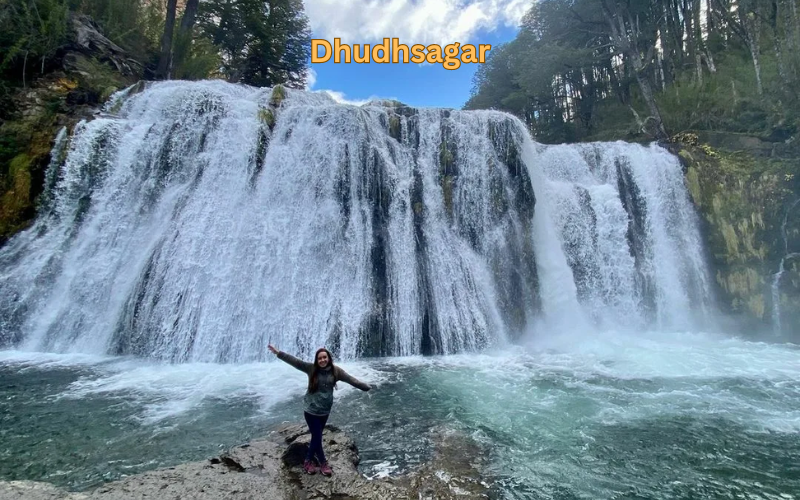
Height: Dudhsagar Falls is one of the tallest waterfalls in India. Total height of approximately 1,017 feet (310 meters). The name “Dudhsagar” translates to “sea of milk”. Which is fitting due to the milky appearance of the water as it cascades down the rocky cliffs.
Area : Situated in the Bhagwan Mahavir Wildlife Sanctuary in the Western Ghats. Dense forests surround the falls, enhancing the natural beauty of the area.
How to reach: A challenging trek through the Bhagwan Mahavir Wildlife Sanctuary allows access to Dudhsagar Falls. Alternatively, there are also jeep safaris that take visitors close to the falls. The falls are approximately 60 kilometers from the state capital, Panaji.
Best Time to Visit: The monsoon season, from June to September, is the best time to witness the falls in all their glory. During this period, the water flow is at its peak, creating a breathtaking sight. Note that you may not allow it during heavy rains.
Flora and Fauna: The surrounding area is rich in biodiversity, and the Bhagwan Mahavir Wildlife Sanctuary is home to various species of flora and fauna. Visitors may encounter diverse plant life, butterflies, and sometimes even wildlife during their journey.
Railway Bridge: Dudhsagar Falls is located near the Dudhsagar Railway Bridge, which is an iconic spot for photography. The sight of the train passing over the bridge against the backdrop of the falls is a popular image.
3. Nohkalikai Falls

Height: Nohkalikai is the tallest plunge waterfall in India, with a total height of approximately 1,115 feet (340 meters). it is located Near the village of Cherrapunji, known for its high annual rainfall and lush landscapes.
The Nohkalikai River creates the falls as it flows over the sharp edge of the Khasi Hills. The water descends dramatically, creating a mesmerizing view.
Name Meaning: The name “Nohkalikai” has a tragic legend associated with it. In the local Khasi language, “Noh” means jump, and “Kalikai” is the name of a woman. According to the legend, a woman named Likai, who suffered from great sorrow, jumped off the cliff, leading to the naming of the falls.
Scenery: The falls are surrounded by lush greenery and mist-covered hills. The landscape around Nohkalikai Falls is picturesque, offering panoramic views of the valleys and forests.
Best Time to Visit: The monsoon season, from June to September, is the best time to witness Nohkalikai Falls to its fullest. However, the region experiences heavy rainfall during this period, so visitors should be prepared for wet and slippery conditions.
Accessibility: Nohkalikai Falls is easily accessible by road from Cherrapunji, which is well-connected to major cities in Meghalaya. Visitors can reach a viewpoint near the falls, offering a stunning vantage point to admire the natural beauty.
Nohkalikai Falls is not only a remarkable natural attraction but also a destination that reflects the rich cultural and mythological heritage of the Khasi people in Meghalaya. It attracts tourists and nature lovers alike, providing an unforgettable experience in the scenic northeastern part of India.
4. Athirappilly Falls
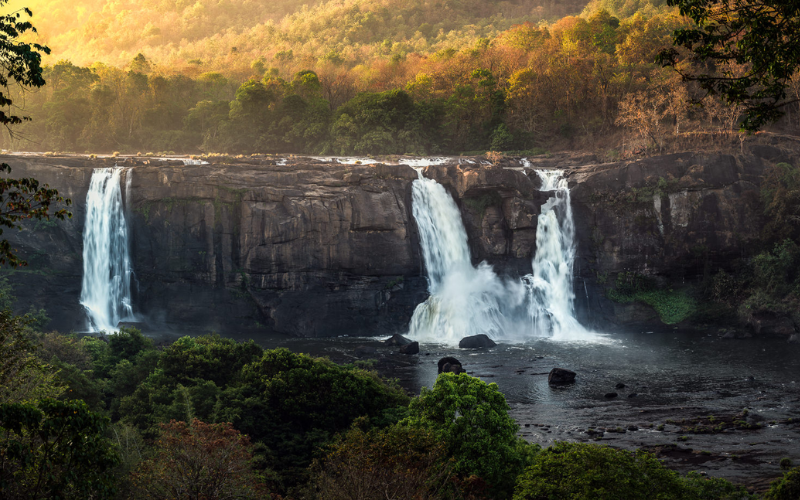
Height: Athirappilly Falls is one of the largest waterfalls in Kerala, with a height of approximately 82 feet (25 meters) and a width of 330 feet (100 meters). The waterfall is formed by the Chalakudy River.
Location: It is situated in the Sholayar forest range near the entrance of the Sholayar ranges, which are part of the Western Ghats. The falls are approximately 60 kilometers from the city of Thrissur.
Surrounding Landscape: The area around Athirappilly Falls is characterized by lush greenery, dense forests, and diverse flora and fauna. The waterfall is surrounded by a scenic landscape, making it a popular spot for nature lovers and photographers.
Vazhachal Falls: Near Athirappilly Falls, there is another waterfall called Vazhachal Falls. Together, Athirapally and Vazhachal form a picturesque cascade amidst the tropical forests.
Film Shooting Location: Athirappilly Falls has been featured in several Indian films, making it a popular location for filmmakers. The scenic beauty and the powerful flow of water make it a visually captivating setting.
Accessibility: The falls are easily accessible by road from various cities in Kerala. There are viewpoints and trekking trails that allow visitors to enjoy different perspectives of the falls.
Best Time to Visit: The monsoon season, from June to September, is when Athirappilly Falls is full of glory. However, the flow of water is substantial throughout the year, and the post-monsoon period is also a good time to visit.
5. Hogenakkal Falls:
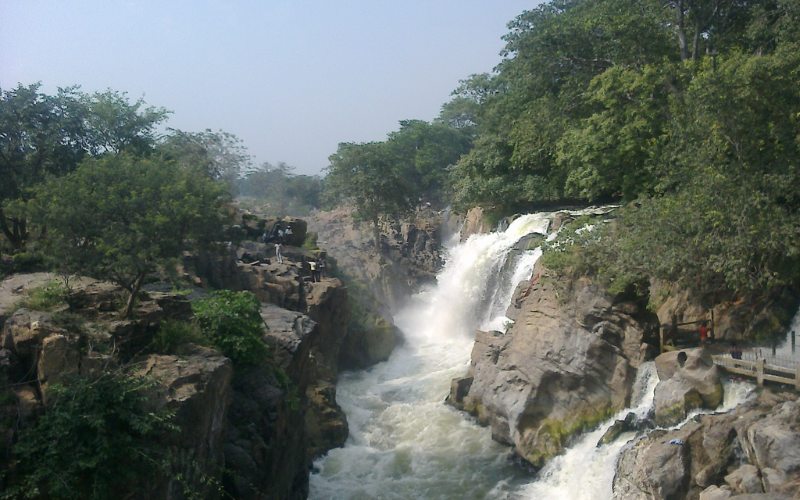
Location: Hogenakkal Falls is situated on the border between the Indian states of Tamil Nadu and Karnataka. It is around 46 kilometers from the town of Dharmapuri in Tamil Nadu.
Formation: The Kaveri River splits into multiple streams, forming a series of falls over rocky terrain. The word “Hogenakkal” translates to “Smoking Rocks” in Kannada, which aptly describes the mist and spray created by the cascading water over the rocks.
Boat Rides: One of the unique features of Hogenakkal Falls is the availability of coracle boat rides. Local boatmen skillfully navigate round, basket-like boats, locally known as “parisal,” through the turbulent waters, providing visitors with an up-close experience of the falls.
Healing Properties: Many believe that the water at Hogenakkal Falls possesses medicinal properties, drawing visitors seeking therapeutic benefits. People commonly take baths in the river, and the local market sells various herbs with perceived healing qualities.
Surrounding Landscape: Lush greenery surrounds the falls, and the area is well known for its picturesque beauty. The rocky terrain and dense forests add to the natural charm of the location.
Best Time to Visit: Considered the best time to visit Hogenakkal Falls, the post-monsoon season spans from October to March. During the monsoon, the water flow is extremely strong, making boat rides more challenging.
Accessibility: Hogenakkal Falls is well-connected by road from nearby towns and cities. Visitors can reach the falls and enjoy the scenic beauty and boat rides.
6. Dhuandhar Falls:
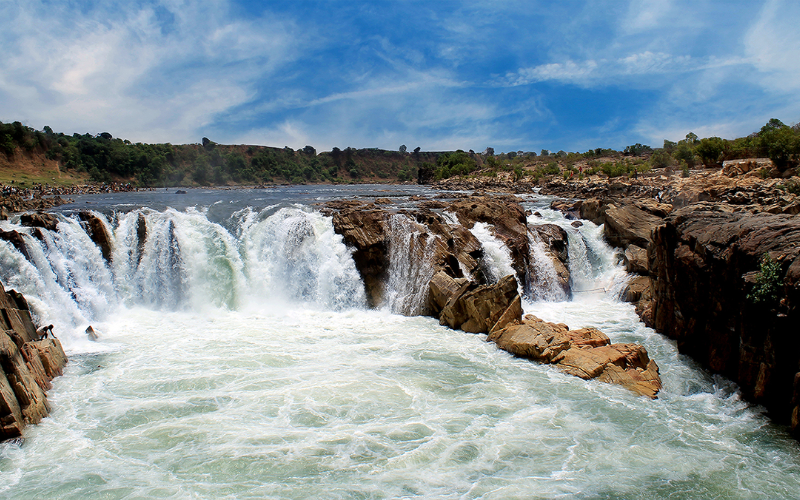
Name Meaning: The name “Dhuandhar” translates to “smoke cascade” in Hindi. The falls derive this name due to the mist and smoke-like appearance created by the water droplets as they cascade down the rocky gorge.
Formation: Dhuandhar Falls is formed by the Narmada River flowing through the marble rocks and creating a gorge. The river narrows down, and the water plunges from a considerable height, creating a spectacular waterfall.
Marble Rocks: The falls are located amidst the famous Marble Rocks, a gorge along the Narmada River with towering cliffs made of marble. The combination of the white marble and the cascading water makes for a visually striking landscape.
Cable Car Ride: Visitors can experience the beauty of Dhuandhar Falls by taking a cable car ride that offers panoramic views of the falls and the surrounding landscape. The cable car takes tourists across the Narmada River, providing a unique vantage point.
Boat Rides: Traditional row boat rides are also available for tourists who want to get closer to the falls. The boat ride allows visitors to appreciate the beauty of the Marble Rocks and witness the powerful flow of the Narmada River.
Best Time to Visit: The post-monsoon season, from October to March, is considered the best time to visit Dhuandhar Falls. During this period, the water flow is moderate, making it an ideal time for sightseeing and boat rides.
Light and Sound Show: Enhancing the overall experience for visitors, a light and sound show is organized at Dhuandhar Falls in the evening. The show narrates the mythology and history associated with the Narmada River.
7. Bhimlat Falls:
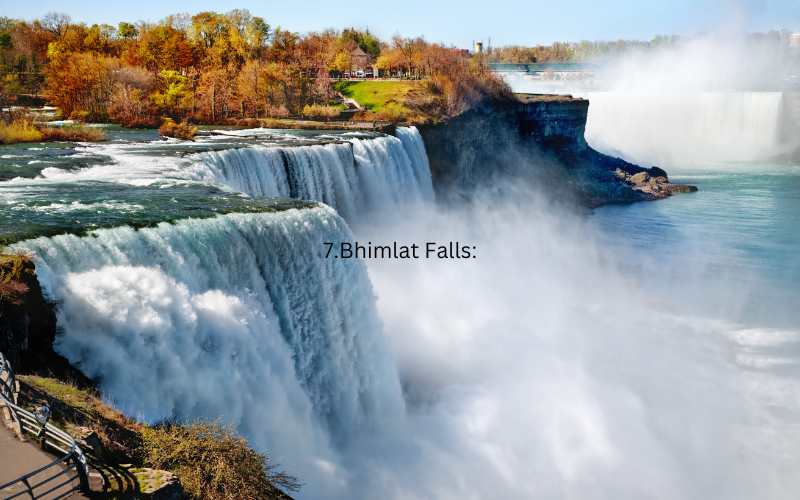
In the heart of Rajasthan, where scorching deserts paint the landscape, lies a hidden oasis – the stunning Bhimlat Falls. A cascading ribbon of water plunging 60 meters down a rocky cliff, Bhimlat offers a refreshing escape from the dry plains, captivating visitors with its natural beauty and rich cultural significance.
Myth and Majesty: Whether myth or reality, the cascading waters possess a magical allure, their roar echoing through the lush green valley below.
A Scenic Sanctuary: Accessible through a scenic drive from Bundi, the journey unfolds with verdant hills and charming villages, culminating in the awe-inspiring sight of the falls. As you descend the winding path, the verdant valley unfolds, carpeted with vibrant wildflowers and dotted with ancient trees. The air vibrates with the symphony of the cascading water, offering a welcome respite from the desert heat.
Temple of Tranquility: Nestled beside the falls rests the ancient Bhimlat Mahadev Temple, dedicated to Lord Shiva. Its serene atmosphere and intricate carvings transport you to a realm of spiritual peace. Witnessing devotees offering prayers amidst the cascading water adds a unique dimension to the experience.
Nature’s Playground: The area around the falls teems with life. Vibrant birds flit through the trees, and playful monkeys swing from branches, adding to the lively atmosphere. For the observant, hidden gems like natural rock formations and hidden trails await discovery.
Beyond the Waterfall: Your Bhimlat experience can extend beyond the falls. Explore the nearby wildlife sanctuary, where a diverse range of flora and fauna thrive. Embark on a village tour, immersing yourself in the local culture and witnessing the traditional way of life.
Best time to visit:
Visit during the monsoon season (July-September) to witness the falls in their full glory.
Carry comfortable shoes and water for the walk to the falls.
Be respectful of the local culture and religious significance of the temple.
Enjoy the natural beauty responsibly and avoid littering.
Bhimlat Falls awaits you, ready to weave its magic and create memories that will last a lifetime.
8. Kempty Falls:
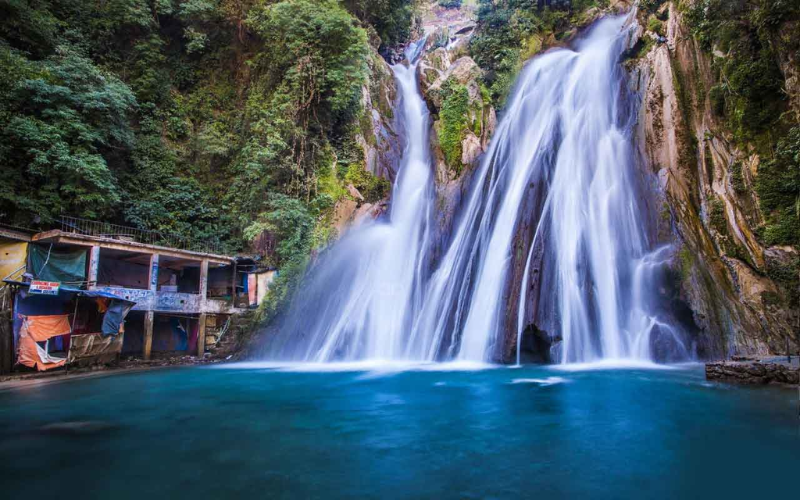
Location: Kempty Falls is located about 13 kilometers from Mussoorie and around 48 kilometers from Dehradun, the capital of Uttarakhand. It is in the lush green hills of the Garhwal region.
Height: The falls are at an altitude of approximately 4,500 feet above sea level. The water cascades down from a height of around 40 feet, creating a scenic and refreshing spectacle
Formation: Formed as mountain streams flow down from the surrounding hills, Kempty Falls exhibits a series of cascading steps that conclude in a large pool at the bottom.
Swimming and Bathing: The pool at the base of Kempty Falls is a popular spot for tourists to take a dip and enjoy a refreshing swim. Many visitors indulge in bathing and playing in the cool waters during the summer months.
Surrounding Area: The surrounding area is covered with dense forests and offers a serene and picturesque environment. There are also various shops and eateries near the falls where visitors can relax and enjoy the scenic beauty.
Accessibility: Kempty Falls is easily accessible by road from Mussoorie and Dehradun. The falls attract a large number of tourists throughout the year, making it one of the prominent attractions in the region.
Best Time to Visit: Considered the optimal time to visit Kempty Falls, the summer months, from March to June, provide pleasant weather and a suitable water flow for bathing and recreational activities.
Kempty Falls is a popular destination for both locals and tourists, offering a refreshing escape into nature and a chance to enjoy the beauty of the Himalayan region. The combination of the cascading water, natural surroundings, and the opportunity to engage in water activities makes it a sought-after spot in Uttarakhand.
9. Irupu Falls:
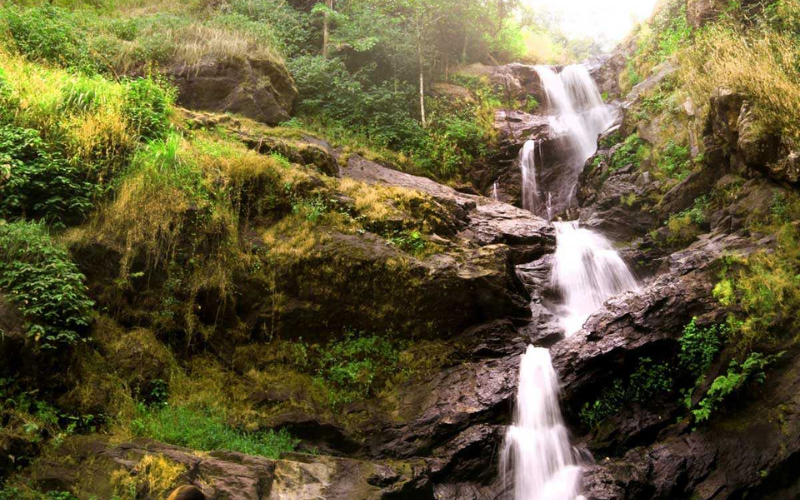
Location: Irupu Falls is located in the Western Ghats, near the border of Karnataka and Kerala. It is approximately 48 kilometers from Madikeri, the district headquarters of Kodagu. It is one of the most famous waterfalls in India
Height: The falls, with a height of about 170 feet (52 meters), are formed by the Lakshmana Tirtha River, a tributary of the Cauvery River.
Religious Significance: Irupu Falls holds religious significance, and there is a Shiva temple known as the Rameshwara Temple located near the falls. The legend associated with the falls is that Lord Rama, accompanied by Lakshmana, shot an arrow into the Brahmagiri hills to bring water to quench the thirst of his wife Sita.
Surrounding Forests: The falls are surrounded by lush greenery and dense forests, adding to the area’s natural beauty. The region is part of the Brahmagiri Wildlife Sanctuary, known for its diverse flora and fauna.
Best Time to Visit: The post-monsoon season, from October to February, is considered the best time to visit Irupu Falls when the weather is pleasant, and the water flow is significant. The monsoon season, from June to September, is when the falls are at their fullest but can be challenging due to heavy rainfall.
Accessibility: Irupu Falls is accessible by road, and visitors need to trek a short distance to reach the falls from the parking area.
Irupu Falls is not only a natural attraction but also a place of cultural and religious importance, making it a popular destination for both nature enthusiasts and pilgrims. The combination of the waterfall, lush landscapes, and the nearby temple contributes to the overall charm of Irupu Falls. Because of these, it takes place in top waterfalls in India
10. Courtallam Falls:
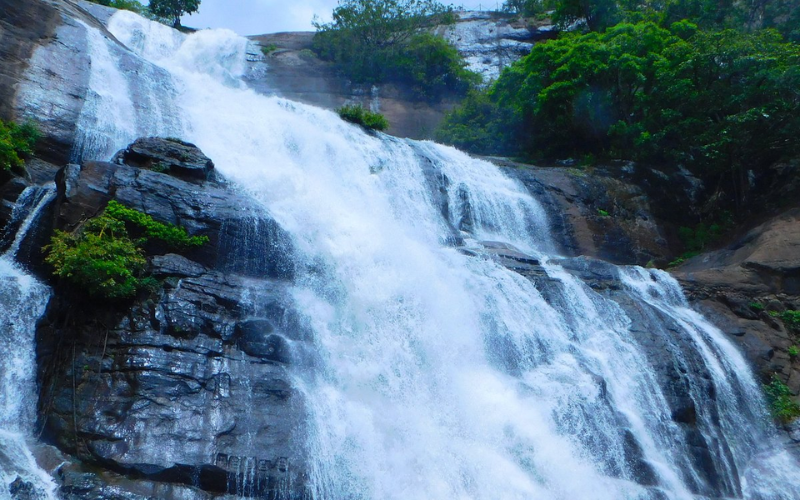
Location: Courtallam is located in the Western Ghats near the town of Tenkasi, approximately 160 kilometers southwest of Madurai. It is situated on the Western Ghats and is often referred to as the “Spa of South India.”
Seasonal Waterfalls: Courtallam is renowned for its seasonal waterfalls, and there are several falls in the region. Some of the prominent ones include Main Falls (Peraruvi), Five Falls (Aintharuvi), Old Courtallam Falls (Pazhaya Courtallam), Tiger Falls (Puli Aruvi), and others.
Therapeutic Baths: People believe that the water from these falls possesses therapeutic properties, drawing visitors who come to bathe for both recreational and medicinal purposes. The water is reputed to provide numerous health benefits due to its richness in minerals.
Main Falls (Peraruvi): This is the most popular and prominent waterfall in Courtallam. The water plunges from a considerable height, creating a picturesque view. There are bathing areas where visitors can enjoy the natural showers.
Five Falls (Aintharuvi): As the name suggests, Five Falls consists of five cascades. Visitors can explore each of these falls, and the area is surrounded by lush greenery.
Tiger Falls (Puli Aruvi): Named “Tiger Falls” due to the sound resembling a tiger’s roar during the monsoon, this waterfall is surrounded by dense forests, enhancing its natural beauty.
Best Time to Visit: The falls are at their peak during the monsoon season, from June to September, when the water flow is abundant. However, the post-monsoon period, from October to March, is also a good time to visit when the weather is pleasant.
These are the top waterfalls in India to explore the beauty of India
You can also read: TOP PLACES IN INDIA: TO EXPLORE THE VIBRANT INDIA
Discover more from Bhuchi's World
Subscribe to get the latest posts sent to your email.

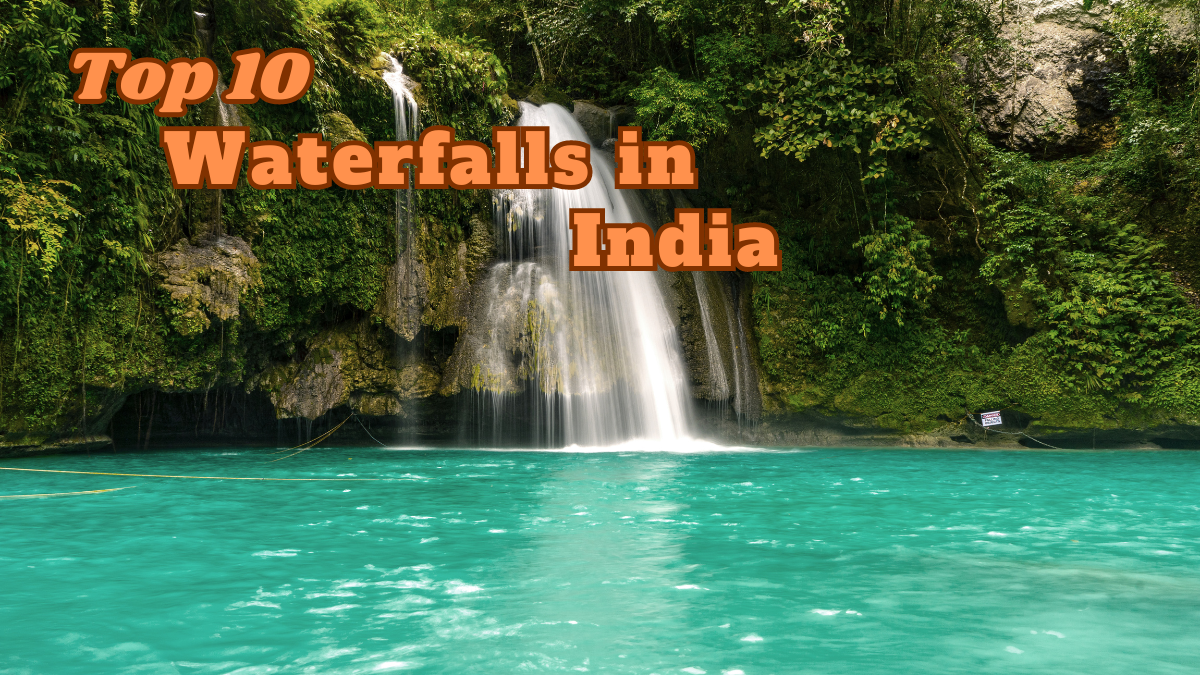
“Bravo!”